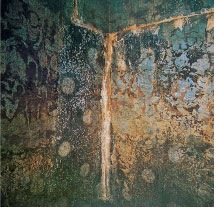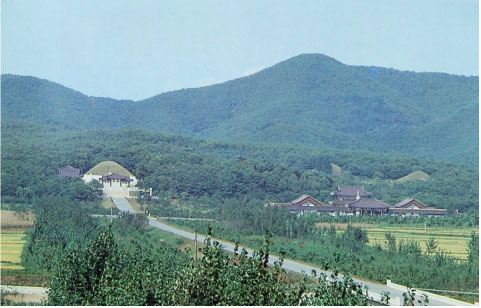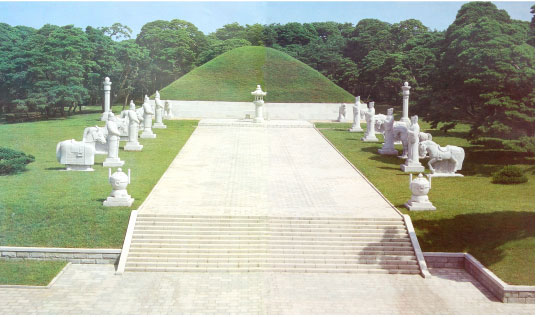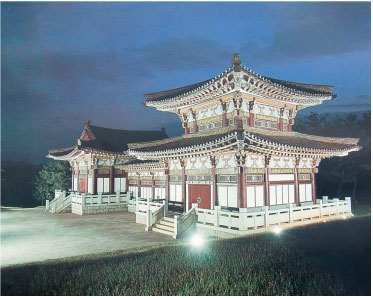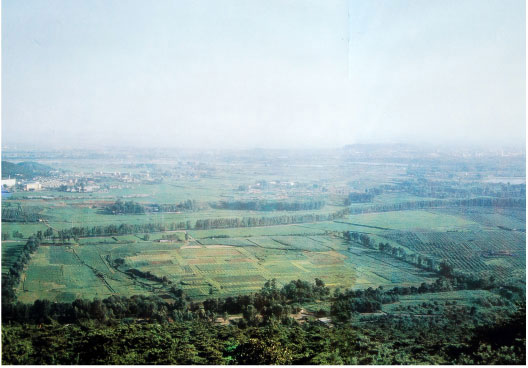
1) Mausoleum of King Tongmyong
Mausoleum of King Tongmyong is the tomb of King Tongmyong (Ko Jumong), the founder of Koguryo which was the first feudal state in Korean history.
The Great Leader Comrade
"The Tomb of King Tongmyong is a very precious historical remnant which shows part of the history and cultural tradition of our country."
The mausoleum is situated in Ryongsan-ri, Ryokpho district, Pyongyang.
As an earthen tomb with stone compartments, it has stone platforms. Its interior consists of a passage, front compartment and inner compartment. On the walls and ceiling of the inside are drawn murals of lotus pattern. The total height of the quadrangular pyramid-like earthen mound was, at the time of its unearthing, 8.15m, of which the height of stone platform (the length of one side is 22m) was 1.5m and the height of base stone was 0.15m. Beside the tomb was a facility of 5m-wide tomb area covered with pebbles.
Found in the tomb were some relics like various shapes of pendent ornament made of gold or gilt bronze. Many relics of Koguyro period were unearthed around the mausoleum. At 150m point in front of the mausoleum was discovered a site of Jongrung temple used when praying for the soul of King Tongmyong. With the mausoleum at the centre, 15 tombs were located at the front and back of the mausoleum as if guarding the mausoleum.
With comprehensive unearthing and readjustment under the wise leadership of President
Under the instruction that President
President
In order to realize the president's intention, leader
Under the wise leadership of the great leaders, the Mausoleum of King Tongmyong was fully restored in an excellent level. The mausoleum comprises 3 areas such as mausoleum area, Jongrung temple area and pearl pond area.
In the mausoleum area there stands the 'Monument to the Restored Mausoleum of King Tongmyong'. Inscribed on the front side of the monument is the title of the monument 'Monument to the Restored Mausoleum of King Tongmyong' handwritten by President
The rebuilt mausoleum has 3-storied platform; one side of each platform is 32m long and 2.1m high, and on the platform is 9.4m-high earthen mound. The total height of the mausoleum is 11.5m. In front of the mausoleum there is a stone table for praying ceremony, stone lantern, a pair of stone posts on both sides. There also stand the sculptures of ministers of Koguryo who made great contributions to founding Koguryo.
Under the farsighted wisdom and warm care of President
2) Site of Anhak Palace
It is a palace site in the period when Koguryo located its capital in the area of Mt. Taesong in Pyongyang.
The site of Anhak Palace is situated at the southern foot of Somun Peak of Mt. Taesong(now Anhak dong, Taesong district, Pyongyang).
The site was excavated for 10 years from Juche 47(1958) to Juche 59(1970), following President
As a result, excavators identified the size of the palace, structure of walls, 6 sites of wall gates and sites of moats, sluice gates and ponds. They also found out the sites of 52 buildings the total floor-space of which amounts to 31 458m² and the sites of 2 590 pillars.
The site of Anhak Palace consists of palace wall and palace site.
The palace wall is a square one with 2 488m in circumference, approximately 380 000 m² wide in floor space and 622m in length of each side. The wall was built with the mixture of stones and clay. There were all together 6 wall gates (3 in the south, one in the east, west and north respectively) and 2 sluice gates (in the north and south each). The site of the southern wall gate was the largest one with its front 37.5m long and side 10m.
Moats were dug outside the east and west of the wall.
The palace site is located on the gentle slope in the southern part of Somun Peak. As for the topography of the site, the northern and central areas are high and the southwestern and eastern areas low.
52 buildings, large and small, were inside the wall. Those buildings comprised 5 groups of buildings. With the north-south central axis in between, the groups stood symmetrically in the east and the west, which made the distribution of groups look very regular and orderly. The five groups or palaces (southern palace, central palace, northern palace, eastern palace and western palace) were connected by corridors. State ceremonies were held in the southern palace. The central palace in the north of southern palace was the one where the king used to conduct his daily affairs of state. Of all the buildings in Anhak Palace Building No.1 of the central palace was the largest, the front of which was 87m long and its side including back building was 27m. The northern palace is presumed to be the bedchamber of the king.
The northern palace was the place where the prince who would succeed to the throne lived. The queen, kuibi (concubines) and princesses were presumed to have lived in the western palace area where there were several buildings.
In addition, there were gardens, ponds and roads paved with stones.
On the site of Anhak Palace which occupies vast areas were discovered relics unique to the period of Koguryo such as roof tiles, chimi (ridge tile ornaments), disguise, glass, inkstone, earthenware, etc.
The site of Anhak Palace has been preserved well as the precious cultural heritage of the Korean nation which demonstrate the mightiness and high level of cultural development of Koguryo, a thousand-year-long powerful state in the east.
3) Taesongsan Fort
It is a mountain fort for the defence of the capital, which was built when Koguryo moved its capital from Kuknae Castle (Ziban, China) to Pyongyang.
Located on Mt. Taesong in Taesong district, Pyongyang, the fort was built along the ridges of 6 peaks such as Ulji Peak, Somun Peak, Jangsu Peak, Pukjang Peak, Kuksa Peak and Jujak Peak.
It was excavated fully from Juche 47(1958) following the instruction of President
The fort was one of the biggest mountain forts of Koguryo.
It was built with 274m-high Kuksa Peak at the centre to connect the ridges of the other 5 peaks around it.
The walls of the fort measures 7 076m and its total length (double walls and triple walls included) is 9 284m. 980m-long double walls were built from Somun Peak to Jujak Peak via south gate; 1 228m-long triple walls in the valley between Jujak Peak and Kuksa Peak. The walls were built in the way of doing groundwork suitable to geographical conditions and then laying sandstone rocks properly trimmed in shape and size and abundant in the area of Mt. Taesong.
The Koguryo people installed various facilities inside and on the walls so that the fort could be a reliable defensive structure: those facilities included an imposing south gate in the middle of double walls and 20 gates of different type, revetment of gates, 65 bastions, command posts and so forth.
There were many ponds in the Taesongsan Fort. According to old records, 99 ponds were in the fort and 3 of them were always full of water. In the process of excavating the fort were discovered around 170 pond sites there. Many of the ponds were fed by underground water.
Several house sites were found and especially a site of 80m-long house was unearthed at the southern foot of Jangsu Peak.
Also found were many relics; a book in a stone case, 2 gilt bronze images of Buddha in a stone chest, harness, bell, earthenware, roof tile, etc. the book is presumed as the Buddhist Scriptures called 'Secret of Paradise'. The gilt bronze image of Buddha is a valuable relic of great significance in demonstrating the wisdom and talent of the Koguryo people and in ascertaining how Buddhism spread to Koguryo.
The Taesongsan Fort, together with Chongamdong Earthen Wall, Kobangsan Wall, Chonghodong Earthen Wall, etc in the vicinity of it, formed a well-organized defensive structure and further reinforced the capital's defence capability of powerful Koguryo.
With its defensive structure and facilities unique to Korea, the Taesongsan Fort becomes a valuable relic displaying outstanding wisdom and talents of Koguryo people.
4) Site of Koguryo Chomsongdae Observatory
Chomsongdae Observatory erected in the period of Koguryo to make meteorological and astronomical observation in detail.
With the help of good and solid-built observatory and equipment, the Koguryo people meticulously observed and recorded the movements of the sun, the moon and other stars, thus making great contributions to the development of meteorology and astronomy.
The site of Chomsongdae Observatory was unearthed in April and May, Juche 98 (2009) in Anhak dong, Taesong district, Pyongyang.
The newly-discovered relics of Koguryo Chomsongdae Observatory are situated in the place 250m to the west of west gate of Anhak Palace Wall located in the southern foot of Somun Peak of Mt. Taesong.
In the vicinity of the relics a number of artifacts of Koguryo period were discovered such as several earthen tombs with stone compartments, roof tiles, pieces of earthenware pots and bowls, etc.
The relics are largely composed of central structure of quadrangle and encircling auxiliary stone structure of heptagon.
The central structure is again divided into inner part and outer part. The inner part was in quadrangular form bulging in the middle with one side 3.2m long, whose bottom was pebbled and on top of it charcoal and lime were packed down firmly in turn, forming a peculiar structure.
The outer part was like a quadrangular mould 2.1m in width encircling the inner part. It was a very solid base structure built up with the mixture of stones and lime.
The auxiliary stone structure of heptagon was constructed by laying stones, making the length of one side 9.1m to 9.2m. Here the bottom was packed hard with a layer of clay and on the clay 2 to 3 layers of stones were built and the space between the stone layers and inner part was filled with soil, thus made the surface level.
The relics faces the south inclining at an angle of 6.5o toward the west, so it is almost due south.
The observatory was erected in the period (from the year 427 to 586) when Koguryo located its capital in the area of Mt. Taesong and used to study the movements of the heavenly bodies and climate change.
The newly-unearthed relics of the Koguryo Chomsongdae Observatory proved that as the observatory was built 200 years earlier than that in Kyongju, Silla and the two are similar in their structure, Koguryo was much further ahead than Silla in the development of astronomy and had great influence on it.
The Chomasongdae Observatory can also be considered as the one built in the earliest period in East Asia.
This evidences that the Korean nation has created advanced and excellent culture from early period in history.




